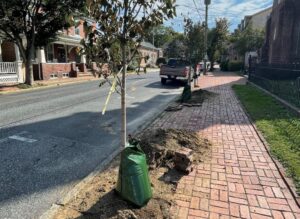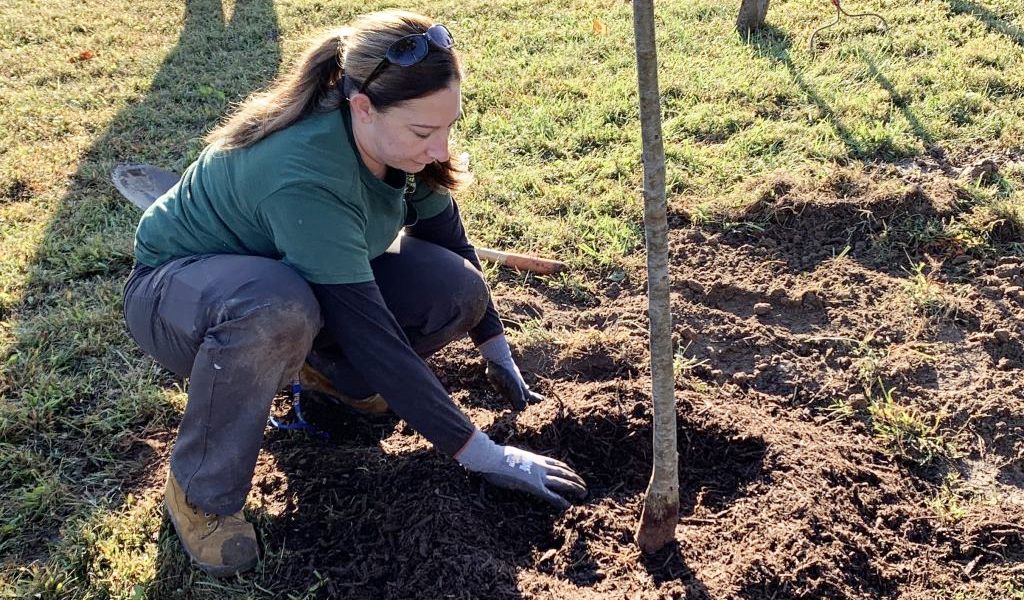Using a program that could and should be replicated in other states, Delaware‘s Urban and Community Forestry Program has awarded $135,193 to help revitalize communities and neighborhoods via 36 tree restoration projects through its annual grant program, which offers up to $5,000 for projects that beautify public land and make community open space healthier.
Ron Vukelich is a New Castle resident who’s worked with the city’s Tree Advisory Commission to revitalize the city’s tree canopy. “The urban community canopy is useful in so many ways. It’s extremely helpful for the health of the community. It’s adding oxygen and removing all kinds of pollutants. At the same time, it’s making houses look a lot better. So, there’s an aesthetic aspect and a wellness portion to it,” he said. “Many of these trees were put in 40 to 50 years ago and they just reached a point where they are in need of refurbishing. So, in essence, this whole main street here is in the process of getting a whole new canopy.”

The City of New Castle received a $5,000 grant to help plant new serviceberry trees along its Main Street. The trees are part of a multi-year project to increase tree canopy and replace aging trees that have grown too large.
(Photo via State of Delaware.)
“That gave us a 17 percent tree canopy in Bowers Beach, which is absolutely not enough. And we are a bird-friendly town.” “We approached Taryn (Davidson) and the UCF Program … and they helped us through with the grant to acquire these trees. So it’s nice for everyone to come here and volunteer and step up instead of stepping back. From what I understand, it’s about $23 an hour [that] goes back to a matching grant of $3500. That goes not to the volunteers, but back to the actual project, for their volunteerism… and… we have about 25 people here today,” he added.
All municipalities, homeowner associations, and certified nonprofits in Delaware can apply. Since it began, the program has provided over 588 grants for more than $1.86 million and planted more than 16,000 trees. The goal is to help communities increase tree canopy and promote the natural benefits of trees: cleaner air and water, increased property values and civic pride, and reduced storm water runoff and flooding.
Grants are made possible by the U.S. Forest Service. State funds and applications are approved by the Delaware Community Forestry Council and U&CF Program staff. Grants are also funded through partnerships with the DNREC Division of Watershed Stewardship Nonpoint Source Program and the DNREC Division of Climate, Coastal and Energy.
Priority is given to first-time applicants, Tree Friendly Communities, and municipalities with urban tree canopy resolutions. Applicants must provide a 50-50 cost share match that can be met through volunteer labor, donated materials and services, or cash. Awards range from $500 to a maximum of $5,000 in one of two project categories, tree planting or tree management, and all projects must take place on public lands.
Taryn Davidson is the Delaware Forest Service’s urban forester. Along with urban forestry director Kesha Braunskill and other staff, Davidson helps communities apply for grant funding and conducts site visits to assess the best locations and select the most appropriate species for tree plantings. “The Town of Bowers was awarded a 2021 urban and community forestry grant, so today we came down here and planted 23 trees,” Davidson said.
“Everyone from the community is here, which is wonderful. It’s nice to have a lot of helping hands on projects like these. One really good benefit from this project is going to be stormwater mitigation. You have a lot of floods coming in from the water behind us, from the beach, so we planted some hackberries and some cedars, which can do well in flooding zones as well as in drought zones. In case we don’t get a lot of rain one summer, they’re still going to be sustainable here,” she added.
Many of the urban forestry grant recipients—including the City of New Castle, the Town of Bowers, the Lutheran Church of the Good Shepherd in Wilmington, and The Seasons Community in Sussex County—completed their planting projects this Fall.
Autumn is an excellent time for tree planting. Temperatures are typically cooler so trees are less likely to be stressed by extreme heat. Fall rains can help trees establish their roots systems. When air temperatures are cooler than the soil, new root growth is encouraged so the tree can have a stronger, better-developed root system for the next spring when the plant begins to grow. Mulching with wood chips also helps retain the soil’s required moisture.
Tink Tocco is the Town of Bowers Parks and Recreation Commissioner. They planted 23 trees in a community open space recently thanks to a $3,500 grant from Delaware’s urban and community program. “We had a tornado last year that blew down nine trees in one of our parks,” Tocco said.
One of the major benefits to the urban and community forestry grant program is how it helps educate residents about trees and their many benefits, while also bringing volunteers together and fostering community spirit.
Melissa Kristic is a Bowers resident who also volunteered at the tree planting event: “I just want to do more within the community, just to help out and beautify it. I love the town. Just to be able to make it prettier. We’re making a lot of improvements around here the last couple of years and it’s been nice watching it grow.”
The funding is distributed according to a variety of goals: Urban and Community Grants; Climate, Coastal and Energy Projects; Chesapeake Bay Grants; Nonpoint Source Program Grants; and Focus Funding Projects.
Here’s an example of how the Urban and Community Grants are distributed:
- Alapocas: $5,000
- City of Newark: $5,000
- Edenridge Civic Association: $5,000
- Pigeon Run Cemetery: $5,000
- Sharpley Civic Association: $5,000
- Westover Hills: $850
- Town of Wyoming: $4,000
- Bay Pointe: $847
- Villas at Bay Crossing: $2,998
- Whartons Bluff B Condo Assoc.: $1,925
- Williams Pond Park – Seaford: $4,000
The U&CF Program partnered with the DNREC Division of Climate, Coastal and Energy (CC&E) to provide funding for tree planting projects in 11 communities this year. The Climate, Coastal and Energy program has goals that focus on carbon sequestration and trees meet this objective by providing long-term carbon storage. Each tree planted through the grant program will have its carbon values calculated and help contribute to the goals in the state’s climate action plan.
As Jay Baker, Bowers resident and tree planting volunteer explained, “I learned a lot here today. The forestry staff were explaining how to take care of the level of the roots and the mulching that goes up around it – all the best practices – so it was very educational. I think it’s good that the program included the volunteer hours because that really brought out the community and we got to spend time out here together and have a really deep appreciation for all these trees that are planted now.”
Delaware is part of the Regional Greenhouse Gas Initiative (RGGI), a multi-state carbon dioxide cap-and-trade program developed as a cooperative effort among the states of Connecticut, Delaware, Maine, Maryland, Massachusetts, New Hampshire, New Jersey, New York, Rhode Island, Vermont and Virginia to cap and reduce carbon dioxide (CO2) emissions from the power sector. Money raised through the initiative is returned to participating states to invest in energy efficiency, renewable energy and other consumer benefit programs. In Delaware, the RGGI program is administered by the Department of Natural Resources and Environmental Control (DNREC).
The USDA Forest Service provides funding to plant trees within the Chesapeake Bay Watershed. Trees help meet goals outlined in Delaware’s Watershed Implementation Plans (WIPs), which include targeted goals that each of the Bay watershed jurisdictions will take to meet the pollution reduction goals of the Chesapeake Bay Total Maximum Daily Load (TMDL) by 2025. These plans consider such things as ecological restoration and sustainability while allowing for greater transparency and accountability for improved performance. The U&CF Program funded two projects for $10,005.
The U&CF Program partnered with the Nonpoint Source Program (NPS) of DNREC to plant trees in EPA priority watersheds in Delaware. The program aims to address the issue of NPS pollution as it affects Delaware’s numerous waterbodies. Efforts include grant funding, education, outreach, and partnerships with other organizations. Reductions in NPS pollution can be achieved through the incorporation or installation of specific best management practices (BMPs) addressing agriculture, silviculture, construction, septic systems, and hydromodification activities. Tree plantings are a BMP that can help intercept stormwater and nutrient runoff, reduce sedimentation and erosion, and filter pollutants. In FY21, $25,006 was provided to six community groups to fund tree projects that address NPS pollution.
The U&CF Program provides annual funding for projects that meet program goals to reach milestones from Delaware’s Forest Action Plan. Each of the projects funded this year provided trees that were planted in areas to help prevent storm damage, mitigate heat island effects, increase tree canopy and foster appreciation for our urban forests.
Featured photo (courtesy State of Delaware) shows the Delaware Forest Service’s urban forester Taryn Davidson, showing volunteers the proper way to mulch a tree at a recent planting event in Bowers Beach, which received a $3,500 grant to plant 23 trees in its community park.

